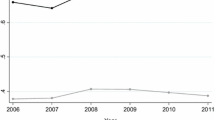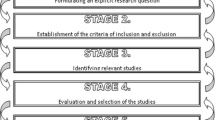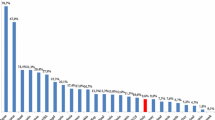Abstract
Inspired by their analysis of universities’ efficiency, Agasisti and Ricca (Ital Econ 2(1):57–89, 2016) on this Journal make a controversial policy proposal on the financing of private universities in Italy. We point out a number of shortcomings in their empirical analysis, interpretation of results and suggestions of policy implications. We show that Agasisti and Ricca’s claims, that universities in the South and public universities are less efficient than private universities and universities in the North, do not rest on solid empirical and conceptual analysis.
Similar content being viewed by others
Notes
We do not refer here to students’ productivity, because as explained in the next section we do not share the view that students should be considered as inputs in universities’ production process. However, the statistical correlation between the number of enrolled students and universities’ efficiency scores (if it was not computed including students among the inputs) could nonetheless denote economies of scale, in so far as the number of students is positively correlated with the number of university staff and the value of revenues and costs.
While in the private sector, firm size is often found to correlate with innovation and R&D activities (for the case of Italy, see Cebula and Rossi 2015), anecdotal evidence and newspaper reports usually identify the larger, public universities with the least efficiency. For this reason, ANVUR’s first research assessment exercise (the Valutazione Triennale della Ricerca, VTR 2001–2003) already produced separate university rankings, dividing Italy’s universities into three size groups.
For a discussion of the role of public and private production of goods and services in recent Italian economic thought, see Biasco (2016).
AR exclude from their sample all online (“telematiche”) universities, but since their policy proposal would apparently benefit them as well, or else we do not see on what basis they would be excluded from an allocation of funding on mere efficiency terms, we decided to keep them in the analysis.
References
Agasisti T, Ricca L (2016) Comparing the efficiency of Italian Public and Private Universities (2007–2011): an empirical analysis. Ital Econ J 2(1):57–89
Biasco S (2016) Due culture, due concezioni dell’impresa pubblica. Moneta e Credito 69(274):207–226
Cebula RJ, Rossi F (2015) Ownership structure and R&D: an empirical analysis of Italian listed companies. PSL Q Rev 68(275):297–325
Corsi M, D’Ippoliti C, Lucidi F (2010) Pluralism at risk? Heterodox economic approaches and the evaluation of economic research in Italy. Am J Econ Sociol 69:1495–1529
Corsi M, D’Ippoliti C, Lucidi F (2011) On the evaluation of economic research: the case of Italy. Econ Politica 3:369–402
Dale SB, Krueger AB (2002) Estimating the payoff of attending a more selective college: an application of selection on observables and unobservables. Q J Econ 107(4):1491–1527
Marcuzzo MC, Zacchia G (2007) L’Econlit come strumento per la valutazione della ricerca in economia. Rivista italiana degli economisti 2:277–306
Marcuzzo MC, Zacchia G (2010) Peso alle citazioni o alla numerosità? La valutazione degli economisti accademici italiani. Politica Econ 3:409–440
Viesti G (ed) (2016) Università in declino. Un’indagine sugli atenei da Nord a Sud, Rapporto di ricerca 2015 della Fondazione Res. Donzelli, Rome
Acknowledgements
The authors gratefully acknowledge financial support from the Institute for New Economic Thinking (INET), grant # INO1500040.
Author information
Authors and Affiliations
Corresponding author
Additional information
We wish to thank Alessandro Roncaglia for the initial suggestion of considering the widespread use among private universities of adjunct faculty who often work as tenured professors in public ones, as a form of potentially distortionary cost competition. The authors remain the sole responsible for all remaining errors and the usual disclaimers apply.
Rights and permissions
About this article
Cite this article
D’Ippoliti, C., Zacchia, G. On the Efficiency of Italian Universities: A Comment. Ital Econ J 3, 113–123 (2017). https://doi.org/10.1007/s40797-016-0042-y
Received:
Accepted:
Published:
Issue Date:
DOI: https://doi.org/10.1007/s40797-016-0042-y




